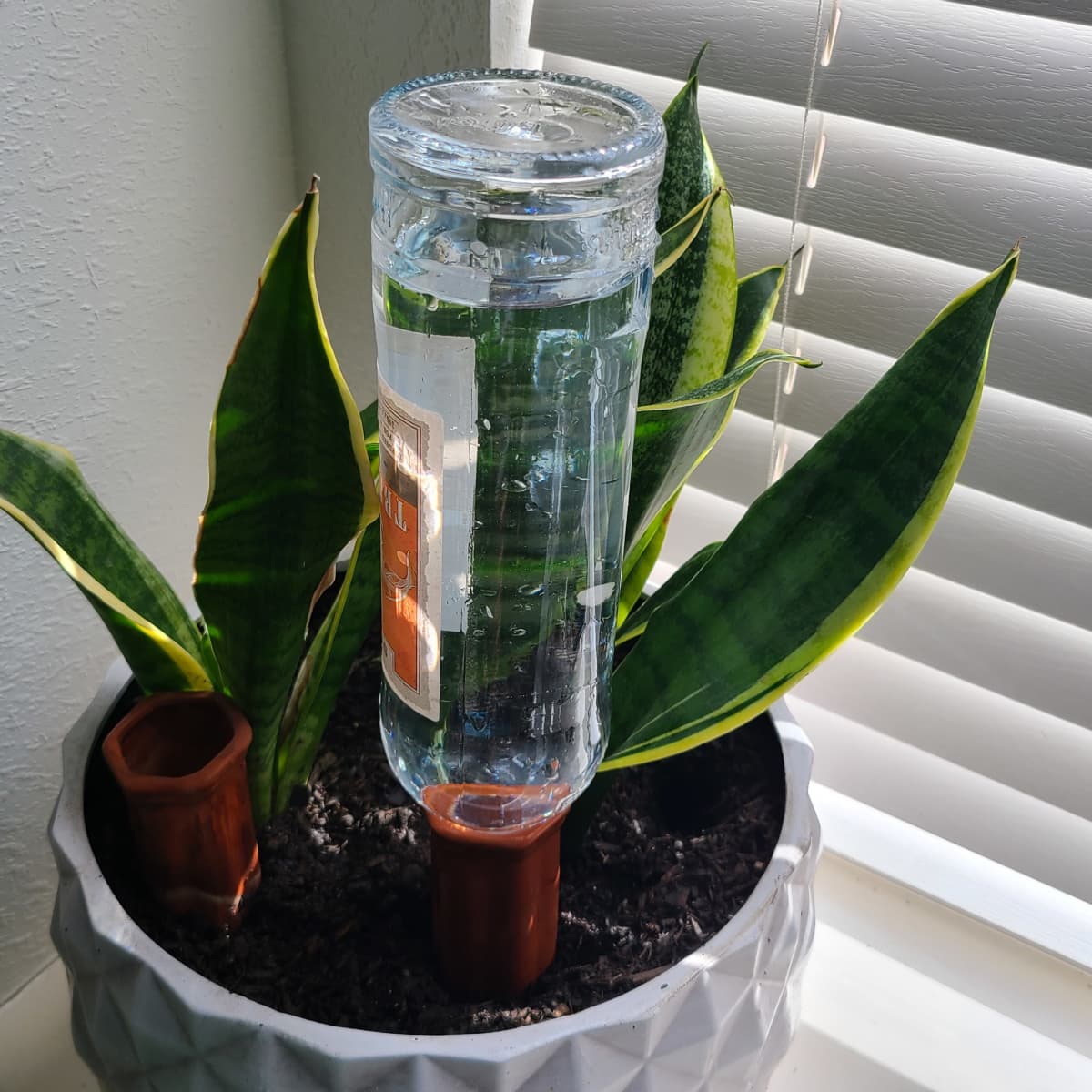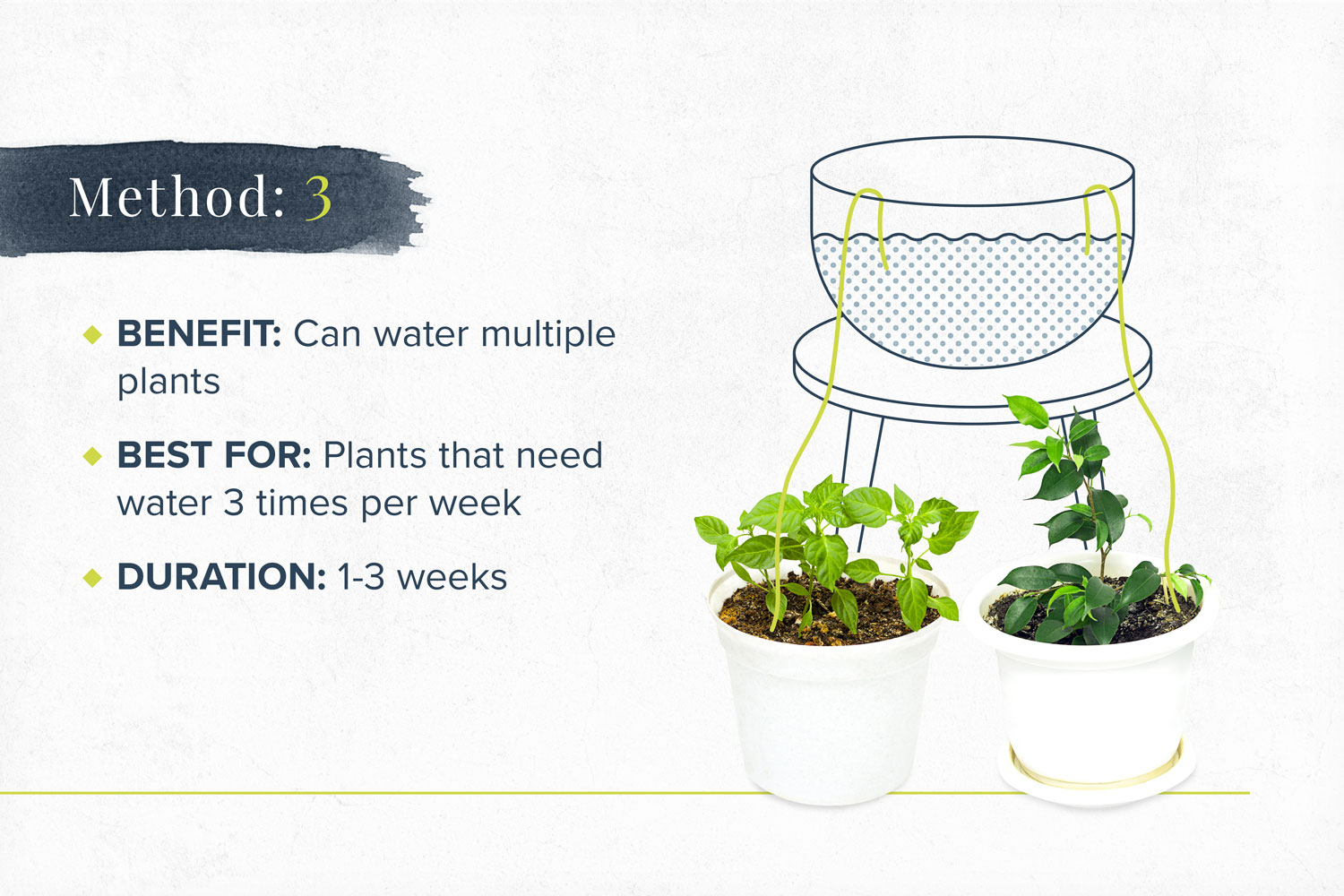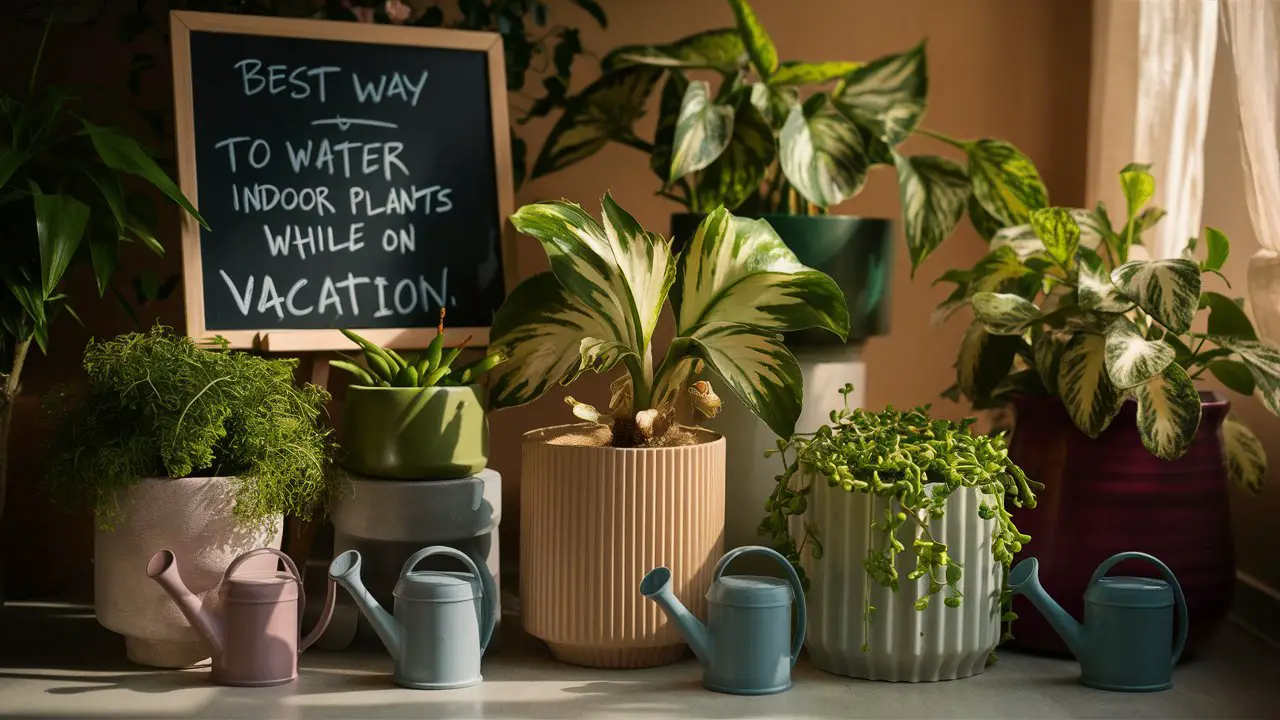The best way to water indoor plants while on vacation is using self-watering systems or asking a friend for help. These methods ensure plants stay hydrated.
Going on vacation can be stressful when you have indoor plants that need regular care. Self-watering systems, such as water globes or capillary mats, provide a reliable way to keep your plants hydrated. These tools release water slowly, ensuring your plants receive consistent moisture.
Alternatively, asking a friend or neighbor to water your plants can also be effective. Setting a clear schedule and providing instructions ensures your plants stay healthy. Both methods offer peace of mind, letting you enjoy your vacation without worrying about your indoor garden.

Credit: dengarden.com
Introduction To Vacation Plant Care
Going on vacation can be exciting, but it also brings some challenges. For plant parents, leaving their indoor plants behind can be a big worry. Indoor plants need regular care, and being away can make this difficult. Don’t worry, with proper planning, your plants can thrive even while you’re away. This guide covers essential tips to ensure your indoor plants stay healthy during your vacation.
The Dilemma Of Plant Parents
Plant parents often face a tough choice before a trip. They want to enjoy their vacation but also want their plants to stay healthy. Plants need water, light, and care. Without these, they can wilt or die. It’s stressful to think about plants suffering in your absence. But there are ways to keep them healthy even when you’re not around.
Essential Plant Care Tips Before You Leave
Preparing your indoor plants for your vacation is crucial. Here are some steps to follow:
- Water Thoroughly: Water your plants well before you leave. Ensure the soil is moist but not soggy.
- Group Plants Together: Place your plants in a group. This creates a humid environment, reducing water loss.
- Use Self-Watering Systems: Install self-watering spikes or systems. These tools release water slowly over time.
- Move Plants Away from Direct Sunlight: Place your plants in a spot with indirect light. This slows down water evaporation.
- Mulch the Soil: Add a layer of mulch to the soil. Mulch helps retain moisture.
- Check for Pests: Inspect your plants for pests. Treat any issues before you go.
By following these tips, you can ensure your plants get the care they need. Your vacation will be stress-free, knowing your indoor plants are in good hands.
Self-watering Solutions
Going on vacation should be relaxing, not stressful. Especially not worrying about your indoor plants. Self-watering solutions can help. These methods ensure your plants get water while you’re away. Let’s explore some effective self-watering solutions.
Diy Wick System
The DIY Wick System is simple and cost-effective. You need a few materials. Here’s how it works:
- Use a cotton rope or strip of cloth as the wick.
- Place one end in a container of water.
- Place the other end in the soil of your plant pot.
The wick will draw water from the container. It keeps the soil moist. This is perfect for small to medium-sized plants.
Commercial Self-watering Stakes
Commercial Self-Watering Stakes are convenient and easy to use. They come in various sizes. Here’s how to use them:
- Fill the stake with water.
- Insert the stake into the soil near the plant.
The stake slowly releases water into the soil. This ensures your plant stays hydrated. These stakes are great for larger plants.
Self-watering solutions are a game changer. They keep your plants healthy while you’re away. Try these methods and enjoy a worry-free vacation.
Harnessing Water Reservoirs
Going on vacation and worried about your indoor plants? You can use water reservoirs to keep them hydrated. These methods are simple and effective. Harnessing water reservoirs ensures your plants get the right amount of water even when you are away. Let’s explore some creative ways to make sure your green friends stay happy.
Creating A Mini Oasis
One effective method is creating a mini oasis for your plants. Use a large container filled with water. Place your potted plants around this container. The water will evaporate slowly, providing moisture to the plants.
This method works best for plants that need high humidity. You can use a tray with pebbles and water for this. Make sure the water level is below the tops of the pebbles. This way, the pots are not sitting in water, but they still get moisture.
Using Water Beads Or Gel
Using water beads or gel is another innovative way. These beads absorb water and release it slowly. They are available in gardening stores and are easy to use.
To use them, soak the beads in water for several hours. Once they are fully expanded, mix them into the soil of your potted plants. The beads will keep releasing water gradually, keeping the soil moist.
Here’s a quick table showing the steps:
| Step | Details |
|---|---|
| 1 | Soak the beads in water for several hours. |
| 2 | Mix the expanded beads into the plant soil. |
| 3 | The beads will release water slowly into the soil. |
Water beads or gel are great for plants that need consistent moisture. They also reduce the risk of overwatering. This simple trick ensures your plants stay hydrated.
Credit: www.quora.com
Automatic Watering Devices
Going on vacation can be stressful for plant lovers. Worrying about plant care is common. Automatic watering devices can help. These devices ensure plants get water while you’re away. Let’s explore some options.
Electronic Watering Systems
Electronic watering systems are great for tech-savvy plant owners. These systems use sensors to monitor soil moisture. When soil gets dry, they water the plants automatically. They often come with mobile apps for easy control. You can adjust water levels remotely. These systems are efficient and save time.
Timed Drip Irrigation
Timed drip irrigation is a reliable method. It delivers water directly to plant roots. You can set the timer to water plants at specific times. This system conserves water and ensures even distribution. Setting up a timed drip system is simple. You need a timer, tubing, and drip emitters. The emitters release water slowly, preventing overwatering.
| Watering Device | Features | Benefits |
|---|---|---|
| Electronic Watering Systems | Sensors, Mobile App Control | Automated, Remote Control, Efficient |
| Timed Drip Irrigation | Timer, Tubing, Drip Emitters | Water Conservation, Even Distribution |
- Electronic Watering Systems: Best for tech-savvy users.
- Timed Drip Irrigation: Simple and reliable.
- Choose an electronic watering system for remote control.
- Set up a timed drip irrigation for even water distribution.
Both systems ensure your plants stay healthy while you’re away.
Natural Humidity Trays
Keeping indoor plants happy while you’re on vacation can be tricky. Natural humidity trays offer a simple solution. They help maintain moisture around your plants. This method uses water and pebbles to create a humid environment. It’s easy to set up and requires little maintenance.
Setting Up Pebble Trays
Setting up a pebble tray is quick and easy. Follow these steps:
- Find a shallow tray that fits your plant pot.
- Fill the tray with pebbles or small stones.
- Add water to the tray until it reaches just below the top of the pebbles.
- Place your plant pot on top of the pebbles.
Ensure the pot does not sit directly in water. The goal is to let the water evaporate and create humidity. This helps the plant absorb moisture through the air.
Maintenance And Monitoring
Keep an eye on the water level in the tray. Check it every few days. Add more water as needed.
- Check the water level regularly.
- Refill the tray when the water is low.
- Clean the pebbles once a month to prevent mold.
Use a soft brush to clean the pebbles. This ensures a healthy environment for your plants.
Monitor your plants for any signs of over-humidity. Some plants may not need as much moisture. Adjust the water level if you see signs of mold or rot.
With these simple steps, your indoor plants can thrive while you’re away. Natural humidity trays are an effective way to maintain plant health. Enjoy your vacation knowing your plants are well cared for.
Mulching For Moisture Retention
Keeping indoor plants hydrated while on vacation can be a challenge. Mulching helps retain moisture in the soil. This method reduces the frequency of watering needed. Mulch acts as a barrier, slowing down water evaporation. Let’s explore how to use mulch effectively.
Choosing The Right Mulch
Selecting the proper mulch is crucial for moisture retention. Various types of mulch work well for indoor plants. Below are some effective options:
- Bark Chips: These are durable and break down slowly.
- Coco Coir: Made from coconut husks, it retains water well.
- Peat Moss: Holds moisture but can become compacted.
- Compost: Enriches the soil while retaining moisture.
| Type of Mulch | Water Retention | Decomposition Rate |
|---|---|---|
| Bark Chips | High | Slow |
| Coco Coir | Very High | Medium |
| Peat Moss | High | Slow |
| Compost | Medium | Fast |
Application Techniques
Proper application of mulch is essential for its effectiveness. Follow these steps for best results:
- Clean the Soil Surface: Remove any debris or fallen leaves.
- Moisten the Soil: Water the soil thoroughly before adding mulch.
- Apply Mulch: Spread a 1-2 inch layer of mulch over the soil.
- Avoid Mulch Piling: Keep mulch away from the plant stem to prevent rot.
- Check Moisture: Ensure the mulch stays damp but not soggy.
Using mulch can greatly aid in keeping your indoor plants healthy. By choosing the right mulch and applying it correctly, you can enjoy your vacation without worrying about your plants.
Grouping Plants For Mutual Benefits
Grouping plants together can help them thrive while you’re on vacation. Plants can create a microclimate that benefits all members of the group. This technique reduces the need for frequent watering.
Microclimate Advantages
Plants release moisture through a process called transpiration. When grouped, this moisture creates a humid environment. This microclimate helps retain water in the soil.
A microclimate also protects plants from temperature fluctuations. This is crucial for tropical plants that need consistent warmth. Additionally, the shade from larger plants can protect smaller ones from direct sunlight.
Grouping can also reduce the airflow around plants. This helps to keep the soil moist for longer periods. It’s a simple way to create a more stable environment for your plants.
Strategic Plant Arrangement
Arrange your plants based on their water needs. Place plants with similar requirements together. This makes it easier to manage their watering schedules.
Use a table to help you organize:
| Plant Type | Watering Frequency | Ideal Grouping |
|---|---|---|
| Succulents | Once a week | Other succulents |
| Tropical Plants | Twice a week | Other tropicals |
| Ferns | Every 2-3 days | Other ferns |
Place larger plants around smaller ones. The larger plants will provide shade and reduce water evaporation. This helps smaller plants stay moist longer.
Use a tray with pebbles filled with water under your plants. This provides extra humidity. Make sure the plant pots don’t sit directly in the water. This prevents root rot.
Finally, consider using self-watering pots. These can provide consistent moisture to your plants. Grouping plants with self-watering pots can be very effective.
Neighborly Plant-sitting Exchange
Leaving your indoor plants unattended during a vacation can be stressful. A Neighborly Plant-Sitting Exchange offers a simple and effective solution. This arrangement involves swapping plant care duties with a neighbor, ensuring your plants remain healthy while you’re away.
Setting Up A Plant Care Swap
To set up a plant care swap, start by finding a trusted neighbor. Look for someone who also loves plants. Discuss the idea of a plant-sitting exchange. Agree on the dates each of you will be away. Create a simple schedule for checking each other’s plants.
It helps to make a list of your plants. Note their specific care needs. This list will guide your neighbor in watering and caring for your plants. Make sure to include any special instructions, like misting or rotating the plants.
Instructions For Plant Sitters
Once you have a plant sitter, provide clear instructions. Write down a step-by-step guide:
- Watering Schedule: Indicate how often each plant needs water.
- Light Requirements: Explain the best spot for sunlight.
- Humidity Needs: Mention if any plants need misting.
- Fertilizing: Specify if any plants need fertilizer during your absence.
| Plant | Watering Frequency | Light Needs | Special Instructions |
|---|---|---|---|
| Fiddle Leaf Fig | Once a week | Bright, indirect light | Mist leaves daily |
| Succulents | Every two weeks | Direct sunlight | Check soil moisture |
| Peace Lily | Twice a week | Low to medium light | Keep soil moist |
Place the list and instructions in a visible spot. This helps your neighbor follow the care routine easily. Offer to return the favor. This builds trust and ensures your plants get the care they need.
Post-vacation Plant Care
After returning from a trip, caring for your indoor plants is essential. They may need some extra attention to bounce back. Below, we’ll discuss key steps to help your plants recover.
Assessing Your Plants’ Health
Start by checking each plant thoroughly. Look for signs of distress such as yellowing leaves, wilted stems, or dry soil. Healthy plants will have firm leaves and moist soil.
| Signs of Health | Signs of Stress |
|---|---|
| Firm Leaves | Yellowing Leaves |
| Moist Soil | Wilted Stems |
Rehabilitating Stressed Plants
If you find any stressed plants, follow these steps:
- Water the plant thoroughly, ensuring the soil is evenly moist.
- Trim away any dead or yellowing leaves.
- Move the plant to a bright, indirect light spot.
- Check the plant for pests and treat if necessary.
Be patient, as plants may take a few days to recover fully. Monitor them daily for progress and make adjustments as needed.

Credit: www.proflowers.com
Frequently Asked Questions
How Do I Keep My Indoor Plants Watered While On Vacation?
Use self-watering planters or place plants in a water-filled tray. Group plants together for humidity. Set up a drip system.
How Long Can Indoor Plants Go Without Water?
Indoor plants can go without water for 1-3 weeks. The duration depends on plant type, size, and environmental conditions.
How To Keep Potted Plants From Drying Out While On Vacation?
Water plants thoroughly before leaving. Use self-watering stakes or systems. Group plants together to retain moisture. Place them in a shaded area. Use mulch to keep soil moist.
What Is The Best Thing To Water Indoor Plants With?
Use room temperature, filtered water for indoor plants. Avoid tap water with chlorine or fluoride. Rainwater is ideal.
Conclusion
Ensuring your indoor plants stay hydrated during vacations is essential. Use self-watering systems or ask a friend for help. Proper planning keeps your plants healthy and thriving. Enjoy your trip knowing your green friends are well cared for. Happy travels and happy gardening!

My mission is to help you bring the beauty of nature indoors with expert advice, detailed plant care guides, and creative design ideas.




